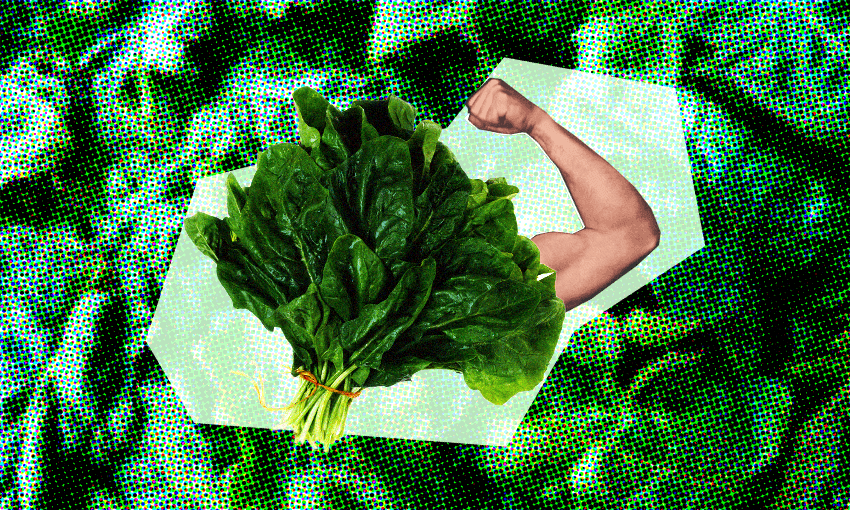Surrounded by myth and legend, this leafy green garden staple has launched a thousand tasty quiches.
It gave Popeye super-strength and is currently exploding in my parents’ garden. Spinach is everyone’s favourite leafy green – versatile, full of nutrients, yet delightfully light on both texture and flavour. No chewing through tough kale stems or pigeon-holing to salads only around here.
Spinach is a complex green beast, however. Although high in vitamins A, C and K, and rich in magnesium, iron, folate, calcium, and manganese, raw spinach also contains a big dose of oxalates, which block the absorption of iron and calcium, and also remove existing iron stores from the body. Sautéed or steamed spinach fares better, as heating breaks down the oxalic acid.
On the flip side, nutrients like folate, vitamin C, and potassium are more available to us in raw spinach. Plus, other substances like tannins (found in tea, cocoa, cereals…) and polyphenols (found in herbs, spices, nuts…) also inhibit iron absorption, so your insides still aren’t safe to absorb iron in peace. It’s all a bit much, really.
My own advice? Eat spinach as you please because it’s still chock full of goodness, and just avoid having a big mug of strong tea at the same time.
Circling back to Popeye for a moment – because what was that all about? In 1870, German chemist Erich von Wolf accidentally wrote that spinach contains 35 milligrams of iron per 100g serving, rather than the true 3.5mg. His typo was published, spinach became well-known as the iron king, and with Popeye it became legend. It wasn’t until 67 years later that someone rechecked the data and corrected it.
Interesting non-iron related fact: in 2020, China produced 92% of the world’s spinach. Who would have thought?
Where you can find it
Spinach is in season, so if you’re lucky enough to have some growing in a garden bed or pot, you know what to do.
Otherwise, a big bag of grown-up spinach is $6.99 from New World, $6.79 from Countdown, $5.99 from Pak’nSave, and $5.79 from Supie. Disclaimer: not all of the supermarkets state exactly how much spinach this is, so you might get a bigger bunch from some supermarkets. Over in baby land, a 120g bag of baby spinach is $3.99 at New World, $3.49 from Pak’nSave, and $4.20 from Supie.
You can also buy 1kg of cooked and frozen spinach at Pak’nSave for $5.49 (quite a good deal), or $3.50 for 500g of frozen spinach from Countdown and New World. While totally inappropriate for a salad, frozen spinach is a solid (ha) replacement for wilted spinach in all sorts of dishes.
How to make it terrible
Steamed, unseasoned, unaccompanied spinach: not exactly the most delicious item on the menu. A smoothie that is more spinach than anything else: maybe for some, but not for me.
Baby spinach, left at the bottom of the veg chiller for days, until all of the leaves have self-wilted from age and miraculously produced a foul brown-yellow liquid: revolting. Eat your spinach in a couple of days, or pay the sad, smelly price.
How to make it amazing
To get the most out of spinach, wilt that bad boy. Not only is wilted spinach better for you, you’ll also be able to eat way more of it. You can wilt spinach by gently sautéeing it in a pan with a little pour of water, steaming it for a couple of minutes, or for a no-cook method, grind over salt and scrunch it with your fingers until – presto – wilt. Just make sure to season your spinach and serve it with something delicious, like eggs Benedict. Yum.
It’s also so easy to throw spinach into basically anything as extra nutrients – a smoothie, soup, stir fry, noodles, a curry. This week I made saag chicken with spiced rice and naan (gently fragrant, just on the edge of creamy, totally comforting) to use up a big pile of spinach from the garden. It was beautiful on a “summer” evening in Auckland, i.e. humid with threatening thick grey clouds. You also get to blitz raw spinach into a dark green foamy liquid, which is much fun.
My favourite spinach dish to make, however, has got to be spinach and feta quiche. I’ve loved this salty green tart since I was little, but until a couple of years ago I always assumed that quiche was difficult to make yourself. So not the case. Now I make this easy spinach quiche about once a month. I use pre-made frozen puff pastry, generally don’t bother blind baking, and in about 20 minutes I’m sliding a (really quite excellent) quiche into the oven.
Quick, that is, unless I spend an extra twenty minutes making elaborate pastry patterns on the top), which is entirely optional but sure to impress everyone. Defrosted frozen spinach is fine too, and if there’s kale or silverbeet in the garden I’ll use that instead. Always serve with tangy sweet chutney to balance the saltiness. Easy as pie… also delicious as pie.
Wyoming Paul is the co-founder of Grossr, and runs a weekly meal plan that connects to online supermarket shopping.

